Question #361
HOTSPOT
-
You are developing an application that uses Azure Storage to store customer data. The data must only be decrypted by the customer and the customer must be provided a script to rotate keys.
You need to provide a script to rotate keys to the customer.
How should you complete the command? To answer, select the appropriate options in the answer area.
NOTE: Each correct selection is worth one point.
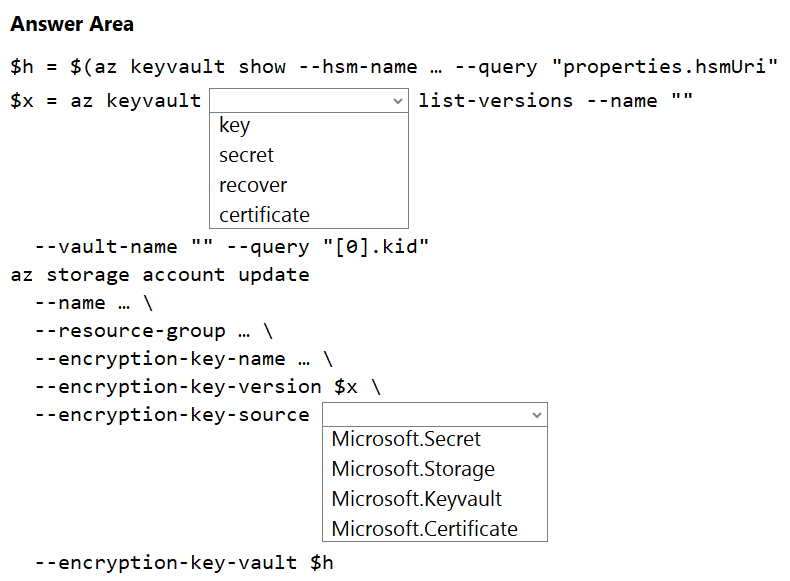
-
You are developing an application that uses Azure Storage to store customer data. The data must only be decrypted by the customer and the customer must be provided a script to rotate keys.
You need to provide a script to rotate keys to the customer.
How should you complete the command? To answer, select the appropriate options in the answer area.
NOTE: Each correct selection is worth one point.

Question #362
You are developing an Azure App Service web app.
The web app must securely store session information in Azure Redis Cache.
You need to connect the web app to Azure Redis Cache.
Which three Azure Redis Cache properties should you use? Each correct answer presents part of the solution.
NOTE: Each correct selection is worth one point.
The web app must securely store session information in Azure Redis Cache.
You need to connect the web app to Azure Redis Cache.
Which three Azure Redis Cache properties should you use? Each correct answer presents part of the solution.
NOTE: Each correct selection is worth one point.
Question #363
HOTSPOT
-
You are developing several microservices to run on Azure Container Apps.
You need to monitor and diagnose the microservices.
Which features should you use? To answer, select the appropriate feature in the answer area.
NOTE: Each correct selection is worth one point.
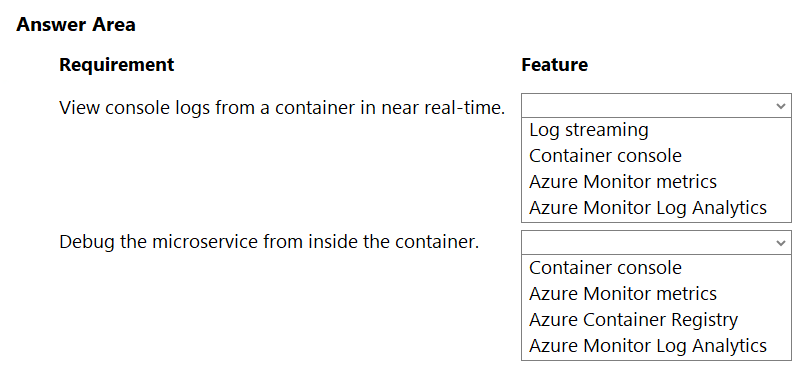
-
You are developing several microservices to run on Azure Container Apps.
You need to monitor and diagnose the microservices.
Which features should you use? To answer, select the appropriate feature in the answer area.
NOTE: Each correct selection is worth one point.

Question #364
You are developing several Azure API Management (APIM) hosted APIs.
The APIs have the following requirements:
• Require a subscription key to access all APIs.
• Include terms of use that subscribers must accept to use the APIs.
• Administrators must review and accept or reject subscription attempts.
• Limit the count of multiple simultaneous subscriptions.
You need to implement the APIs.
What should you do?
The APIs have the following requirements:
• Require a subscription key to access all APIs.
• Include terms of use that subscribers must accept to use the APIs.
• Administrators must review and accept or reject subscription attempts.
• Limit the count of multiple simultaneous subscriptions.
You need to implement the APIs.
What should you do?
Question #365
HOTSPOT
-
You are developing a solution by using the Azure Event Hubs SDK. You create a standard Azure Event Hub with 16 partitions. You implement eight event processor clients.
You must balance the load dynamically when an event processor client fails. When an event processor client fails, another event processor must continue processing from the exact point at which the failure occurred. All events must be aggregate and upload to an Azure Blob storage account.
You need to implement event processing recovery for the solution.
Which SDK features should you use? To answer, select the appropriate options in the answer area.
NOTE: Each correct selection is worth one point.
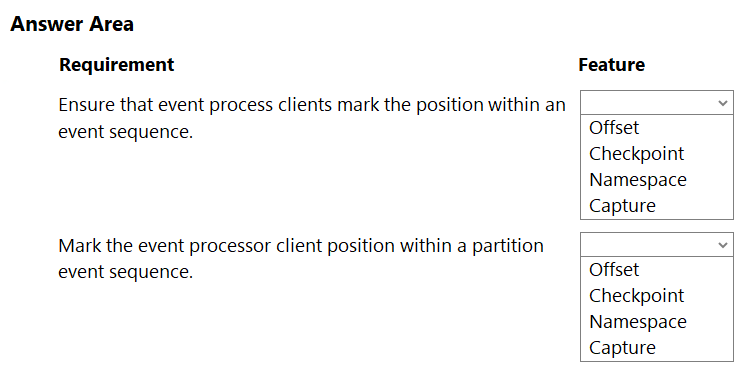
-
You are developing a solution by using the Azure Event Hubs SDK. You create a standard Azure Event Hub with 16 partitions. You implement eight event processor clients.
You must balance the load dynamically when an event processor client fails. When an event processor client fails, another event processor must continue processing from the exact point at which the failure occurred. All events must be aggregate and upload to an Azure Blob storage account.
You need to implement event processing recovery for the solution.
Which SDK features should you use? To answer, select the appropriate options in the answer area.
NOTE: Each correct selection is worth one point.

Question #366
HOTSPOT
-
You are developing a new API to be hosted by Azure API Management (APIM). The backend service that implements the API has not been completed. You are creating a test API and operation.
You must enable developers to continue with the implementation and testing of the APIM instance integrations while you complete the backend API development.
You need to configure a test API response.
How should you complete the configuration? To answer, select the appropriate options in the answer area.
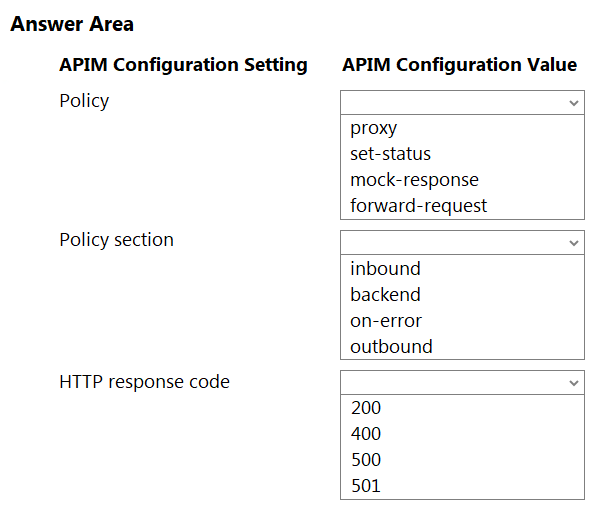
-
You are developing a new API to be hosted by Azure API Management (APIM). The backend service that implements the API has not been completed. You are creating a test API and operation.
You must enable developers to continue with the implementation and testing of the APIM instance integrations while you complete the backend API development.
You need to configure a test API response.
How should you complete the configuration? To answer, select the appropriate options in the answer area.

Question #367
You are developing several Azure API Management (APIM) hosted APIs.
You must inspect request processing of the APIs in APIM. Requests to APIM by using a REST client must also be included. The request inspection must include the following information:
• requests APIM sent to the API backend and the response it received
• policies applied to the response before sending back to the caller
• errors that occurred during the processing of the request and the policies applied to the errors
• original request APIM received from the caller and the policies applied to the request
You need to inspect the APIs.
Which three actions should you do? Each correct answer presents part of the solution.
NOTE: Each correct selection is worth one point.
You must inspect request processing of the APIs in APIM. Requests to APIM by using a REST client must also be included. The request inspection must include the following information:
• requests APIM sent to the API backend and the response it received
• policies applied to the response before sending back to the caller
• errors that occurred during the processing of the request and the policies applied to the errors
• original request APIM received from the caller and the policies applied to the request
You need to inspect the APIs.
Which three actions should you do? Each correct answer presents part of the solution.
NOTE: Each correct selection is worth one point.
Question #368
Case study -
This is a case study. Case studies are not timed separately. You can use as much exam time as you would like to complete each case. However, there may be additional case studies and sections on this exam. You must manage your time to ensure that you are able to complete all questions included on this exam in the time provided.
To answer the questions included in a case study, you will need to reference information that is provided in the case study. Case studies might contain exhibits and other resources that provide more information about the scenario that is described in the case study. Each question is independent of the other questions in this case study.
At the end of this case study, a review screen will appear. This screen allows you to review your answers and to make changes before you move to the next section of the exam. After you begin a new section, you cannot return to this section.
To start the case study -
To display the first question in this case study, click the Next button. Use the buttons in the left pane to explore the content of the case study before you answer the questions. Clicking these buttons displays information such as business requirements, existing environment, and problem statements. When you are ready to answer a question, click the Question button to return to the question.
Background -
VanArsdel, Ltd. is a global office supply company. The company is based in Canada and has retail store locations across the world. The company is developing several cloud-based solutions to support their stores, distributors, suppliers, and delivery services.
Current environment -
Corporate website -
The company provides a public website located at http://www.vanarsdelltd.com. The website consists of a React JavaScript user interface, HTML, CSS, image assets, and several APIs hosted in Azure Functions.
Retail Store Locations -
The company supports thousands of store locations globally. Store locations send data every hour to an Azure Blob storage account to support inventory, purchasing and delivery services. Each record includes a location identifier and sales transaction information.
Requirements -
The application components must meet the following requirements:
Corporate website -
• Secure the website by using SSL.
• Minimize costs for data storage and hosting.
• Implement native GitHub workflows for continuous integration and continuous deployment (CI/CD).
• Distribute the website content globally for local use.
• Implement monitoring by using Application Insights and availability web tests including SSL certificate validity and custom header value verification.
• The website must have 99.95 percent uptime.
Retail store locations -
• Azure Functions must process data immediately when data is uploaded to Blob storage. Azure Functions must update Azure Cosmos DB by using native SQL language queries.
• Audit store sale transaction information nightly to validate data, process sales financials, and reconcile inventory.
Delivery services -
• Store service telemetry data in Azure Cosmos DB by using an Azure Function. Data must include an item id, the delivery vehicle license plate, vehicle package capacity, and current vehicle location coordinates.
• Store delivery driver profile information in Azure Active Directory (Azure AD) by using an Azure Function called from the corporate website.
Inventory services -
The company has contracted a third-party to develop an API for inventory processing that requires access to a specific blob within the retail store storage account for three months to include read-only access to the data.
Security -
• All Azure Functions must centralize management and distribution of configuration data for different environments and geographies, encrypted by using a company-provided RSA-HSM key.
• Authentication and authorization must use Azure AD and services must use managed identities where possible.
Issues -
Retail Store Locations -
• You must perform a point-in-time restoration of the retail store location data due to an unexpected and accidental deletion of data.
• Azure Cosmos DB queries from the Azure Function exhibit high Request Unit (RU) usage and contain multiple, complex queries that exhibit high point read latency for large items as the function app is scaling.
You need to test the availability of the corporate website.
Which two test types can you use? Each correct answer presents a complete solution.
NOTE: Each correct selection is worth one point.
This is a case study. Case studies are not timed separately. You can use as much exam time as you would like to complete each case. However, there may be additional case studies and sections on this exam. You must manage your time to ensure that you are able to complete all questions included on this exam in the time provided.
To answer the questions included in a case study, you will need to reference information that is provided in the case study. Case studies might contain exhibits and other resources that provide more information about the scenario that is described in the case study. Each question is independent of the other questions in this case study.
At the end of this case study, a review screen will appear. This screen allows you to review your answers and to make changes before you move to the next section of the exam. After you begin a new section, you cannot return to this section.
To start the case study -
To display the first question in this case study, click the Next button. Use the buttons in the left pane to explore the content of the case study before you answer the questions. Clicking these buttons displays information such as business requirements, existing environment, and problem statements. When you are ready to answer a question, click the Question button to return to the question.
Background -
VanArsdel, Ltd. is a global office supply company. The company is based in Canada and has retail store locations across the world. The company is developing several cloud-based solutions to support their stores, distributors, suppliers, and delivery services.
Current environment -
Corporate website -
The company provides a public website located at http://www.vanarsdelltd.com. The website consists of a React JavaScript user interface, HTML, CSS, image assets, and several APIs hosted in Azure Functions.
Retail Store Locations -
The company supports thousands of store locations globally. Store locations send data every hour to an Azure Blob storage account to support inventory, purchasing and delivery services. Each record includes a location identifier and sales transaction information.
Requirements -
The application components must meet the following requirements:
Corporate website -
• Secure the website by using SSL.
• Minimize costs for data storage and hosting.
• Implement native GitHub workflows for continuous integration and continuous deployment (CI/CD).
• Distribute the website content globally for local use.
• Implement monitoring by using Application Insights and availability web tests including SSL certificate validity and custom header value verification.
• The website must have 99.95 percent uptime.
Retail store locations -
• Azure Functions must process data immediately when data is uploaded to Blob storage. Azure Functions must update Azure Cosmos DB by using native SQL language queries.
• Audit store sale transaction information nightly to validate data, process sales financials, and reconcile inventory.
Delivery services -
• Store service telemetry data in Azure Cosmos DB by using an Azure Function. Data must include an item id, the delivery vehicle license plate, vehicle package capacity, and current vehicle location coordinates.
• Store delivery driver profile information in Azure Active Directory (Azure AD) by using an Azure Function called from the corporate website.
Inventory services -
The company has contracted a third-party to develop an API for inventory processing that requires access to a specific blob within the retail store storage account for three months to include read-only access to the data.
Security -
• All Azure Functions must centralize management and distribution of configuration data for different environments and geographies, encrypted by using a company-provided RSA-HSM key.
• Authentication and authorization must use Azure AD and services must use managed identities where possible.
Issues -
Retail Store Locations -
• You must perform a point-in-time restoration of the retail store location data due to an unexpected and accidental deletion of data.
• Azure Cosmos DB queries from the Azure Function exhibit high Request Unit (RU) usage and contain multiple, complex queries that exhibit high point read latency for large items as the function app is scaling.
You need to test the availability of the corporate website.
Which two test types can you use? Each correct answer presents a complete solution.
NOTE: Each correct selection is worth one point.
Question #369
You are developing several Azure API Management (APIM) hosted APIs.
You must transform the APIs to hide private backend information and obscure the technology stack used to implement the backend processing.
You need to protect all APIs.
What should you do?
You must transform the APIs to hide private backend information and obscure the technology stack used to implement the backend processing.
You need to protect all APIs.
What should you do?
Question #370
You have an Azure API Management (APIM) Standard tier instance named APIM1 that uses a managed gateway.
You plan to use APIM1 to publish an API named API1 that uses a backend database that supports only a limited volume of requests per minute. You also need a policy for API1 that will minimize the possibility that the number of requests to the backend database from an individual IP address you specify exceeds the supported limit.
You need to identify a policy for API1 that will meet the requirements.
Which policy should you use?
You plan to use APIM1 to publish an API named API1 that uses a backend database that supports only a limited volume of requests per minute. You also need a policy for API1 that will minimize the possibility that the number of requests to the backend database from an individual IP address you specify exceeds the supported limit.
You need to identify a policy for API1 that will meet the requirements.
Which policy should you use?
Question #371
A company is developing a solution that allows smart refrigerators to send temperature information to a central location.
The solution must receive and store messages until they can be processed. You create an Azure Service Bus instance by providing a name, pricing tier, subscription, resource group, and location.
You need to complete the configuration.
Which Azure CLI or PowerShell command should you run?
The solution must receive and store messages until they can be processed. You create an Azure Service Bus instance by providing a name, pricing tier, subscription, resource group, and location.
You need to complete the configuration.
Which Azure CLI or PowerShell command should you run?
Question #372
HOTSPOT
-
You plan to implement an Azure Functions app.
The Azure Functions app has the following requirements:
• Must be triggered by a message placed in an Azure Storage queue.
• Must use the queue name set by an app setting named input_queue.
• Must create an Azure Blob Storage named the same as the content of the message.
You need to identify how to reference the queue and blob name in the function.json file of the Azure Functions app.
How should you reference the names? To answer, select the appropriate values in the answer area.
NOTE: Each correct selection is worth one point.
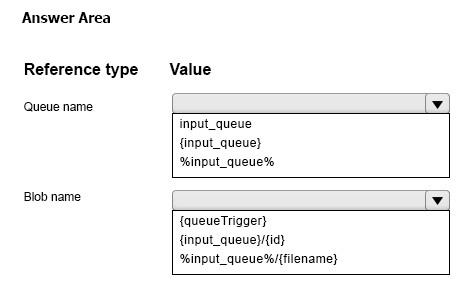
-
You plan to implement an Azure Functions app.
The Azure Functions app has the following requirements:
• Must be triggered by a message placed in an Azure Storage queue.
• Must use the queue name set by an app setting named input_queue.
• Must create an Azure Blob Storage named the same as the content of the message.
You need to identify how to reference the queue and blob name in the function.json file of the Azure Functions app.
How should you reference the names? To answer, select the appropriate values in the answer area.
NOTE: Each correct selection is worth one point.

Question #373
HOTSPOT
-
You have an Azure API Management instance named API1 that uses a managed gateway.
You plan to implement a policy that will apply at a product scope and will set the header of inbound requests to include information about the region hosting the gateway of API1. The policy definition contains the following content:

You have the following requirements for the policy definition:
• Ensure that the header contains the information about the region hosting the gateway of API1.
• Ensure the policy applies only after any global level policies are processed first.
You need to complete the policy definition.
Which values should you choose? To answer, select the appropriate options in the answer area.
NOTE: Each correct selection is worth one point.
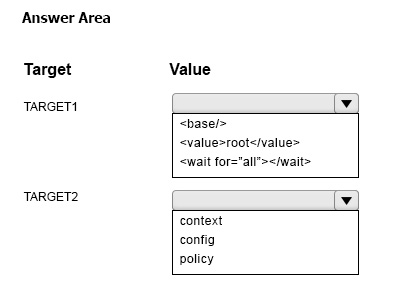
-
You have an Azure API Management instance named API1 that uses a managed gateway.
You plan to implement a policy that will apply at a product scope and will set the header of inbound requests to include information about the region hosting the gateway of API1. The policy definition contains the following content:

You have the following requirements for the policy definition:
• Ensure that the header contains the information about the region hosting the gateway of API1.
• Ensure the policy applies only after any global level policies are processed first.
You need to complete the policy definition.
Which values should you choose? To answer, select the appropriate options in the answer area.
NOTE: Each correct selection is worth one point.

Question #374
You are developing several Azure API Management (APIM) hosted APIs.
You must make several minor and non-breaking changes to one of the APIs. The API changes include the following requirements:
• Must not disrupt callers of the API.
• Enable roll back if you find issues.
• Documented to enable developers to understand what is new.
• Tested before publishing.
You need to update the API.
What should you do?
You must make several minor and non-breaking changes to one of the APIs. The API changes include the following requirements:
• Must not disrupt callers of the API.
• Enable roll back if you find issues.
• Documented to enable developers to understand what is new.
• Tested before publishing.
You need to update the API.
What should you do?
Question #375
HOTSPOT
-
You are developing an application to store millions of images in Azure blob storage.
The application has the following requirements:
• Store the Exif (exchangeable image file format) data from the image as blob metadata when the application uploads the image.
• Retrieve the Exif data from the image while minimizing bandwidth and processing time.
• Utilizes the REST API.
You need to use the image Exif data as blob metadata in the application.
Which HTTP verbs should you use? To answer, select the appropriate options in the answer area.
NOTE: Each correct selection is worth one point.
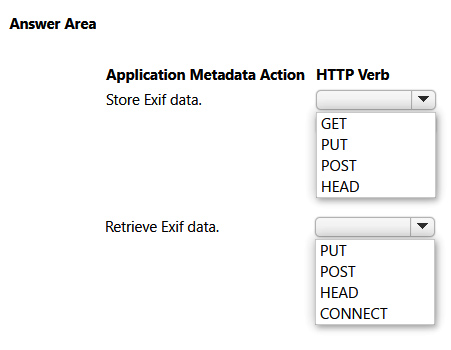
-
You are developing an application to store millions of images in Azure blob storage.
The application has the following requirements:
• Store the Exif (exchangeable image file format) data from the image as blob metadata when the application uploads the image.
• Retrieve the Exif data from the image while minimizing bandwidth and processing time.
• Utilizes the REST API.
You need to use the image Exif data as blob metadata in the application.
Which HTTP verbs should you use? To answer, select the appropriate options in the answer area.
NOTE: Each correct selection is worth one point.

Question #376
You are developing several microservices to run on Azure Container Apps for a company. External TCP ingress traffic from the internet has been enabled for the microservices.
The company requires that the microservices must scale based on an Azure Event Hub trigger.
You need to scale the microservices by using a custom scaling rule.
Which two Kubernetes Event-driven Autoscaling (KEDA) trigger fields should you use? Each correct answer presents part of the solution.
NOTE: Each correct selection is worth one point.
The company requires that the microservices must scale based on an Azure Event Hub trigger.
You need to scale the microservices by using a custom scaling rule.
Which two Kubernetes Event-driven Autoscaling (KEDA) trigger fields should you use? Each correct answer presents part of the solution.
NOTE: Each correct selection is worth one point.
Question #377
HOTSPOT
-
You are developing an Azure Function App named App1. You also plan to use cross-origin requests (CORS).
You have the following requirements:
• App1 functions must securely access an Azure Blob Storage account.
• Access to the Azure Blob Storage account must not require the provisioning or rotation of secrets.
• JavaScript code running in a browser on an external host must not be allowed to interact with the function.
You need to implement App1.
Which configuration should you use? To answer, select the appropriate options in the answer area.
NOTE: Each correct selection is worth one point.

-
You are developing an Azure Function App named App1. You also plan to use cross-origin requests (CORS).
You have the following requirements:
• App1 functions must securely access an Azure Blob Storage account.
• Access to the Azure Blob Storage account must not require the provisioning or rotation of secrets.
• JavaScript code running in a browser on an external host must not be allowed to interact with the function.
You need to implement App1.
Which configuration should you use? To answer, select the appropriate options in the answer area.
NOTE: Each correct selection is worth one point.

Question #378
You develop a web application that sells access to last-minute openings for child camps that run on the weekends. The application uses Azure Application Insights for all alerting and monitoring.
The application must alert operators when a technical issue is preventing sales to camps.
You need to build an alert to detect technical issues.
Which alert type should you use?
The application must alert operators when a technical issue is preventing sales to camps.
You need to build an alert to detect technical issues.
Which alert type should you use?
Question #379
A company is developing a solution that allows smart refrigerators to send temperature information to a central location.
The solution must receive and store messages until they can be processed. You create an Azure Service Bus instance by providing a name, pricing tier, subscription, resource group, and location.
You need to complete the configuration.
Which Azure CLI or PowerShell command should you run?
The solution must receive and store messages until they can be processed. You create an Azure Service Bus instance by providing a name, pricing tier, subscription, resource group, and location.
You need to complete the configuration.
Which Azure CLI or PowerShell command should you run?
Question #380
A company is developing a solution that allows smart refrigerators to send temperature information to a central location.
The solution must receive and store messages until they can be processed. You create an Azure Service Bus instance by providing a name, pricing tier, subscription, resource group, and location.
You need to complete the configuration.
Which Azure CLI or PowerShell command should you run?
The solution must receive and store messages until they can be processed. You create an Azure Service Bus instance by providing a name, pricing tier, subscription, resource group, and location.
You need to complete the configuration.
Which Azure CLI or PowerShell command should you run?
Question #381
A company is developing a solution that allows smart refrigerators to send temperature information to a central location.
The solution must receive and store messages until they can be processed. You create an Azure Service Bus instance by providing a name, pricing tier, subscription, resource group, and location.
You need to complete the configuration.
Which Azure CLI or PowerShell command should you run?
The solution must receive and store messages until they can be processed. You create an Azure Service Bus instance by providing a name, pricing tier, subscription, resource group, and location.
You need to complete the configuration.
Which Azure CLI or PowerShell command should you run?
Question #382
HOTSPOT
-
You develop a containerized application. The application must be deployed to an existing Azure Kubernetes Service (AKS) cluster from an Azure Container Registry (ACR) instance. You use the Azure command-line interface (Azure CLI) to deploy the application image to AKS.
Images must be pulled from the registry. You must be able to view all registries within the current Azure subscription. Authentication must be managed by Microsoft Entra ID and removed when the registry is deleted. The solution must use the principle of least privilege.
You need to configure authentication to the registry.
Which authentication configuration should you use? To answer, select the appropriate configuration values in the answer area,
NOTE: Each correct selection is worth one point.
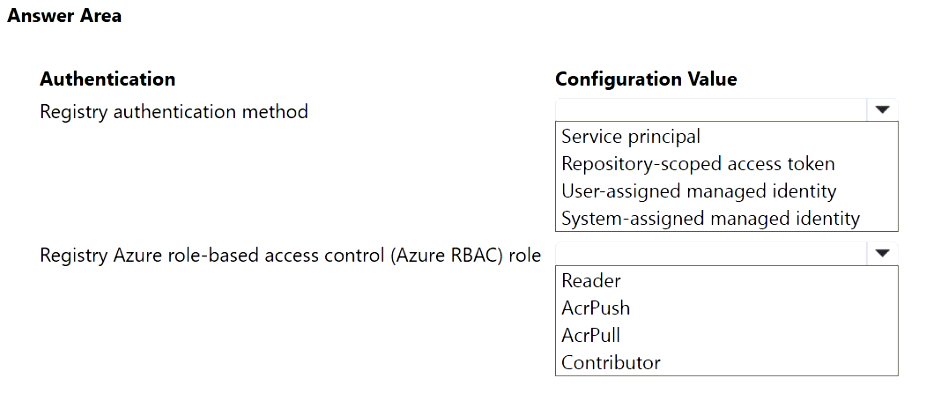
-
You develop a containerized application. The application must be deployed to an existing Azure Kubernetes Service (AKS) cluster from an Azure Container Registry (ACR) instance. You use the Azure command-line interface (Azure CLI) to deploy the application image to AKS.
Images must be pulled from the registry. You must be able to view all registries within the current Azure subscription. Authentication must be managed by Microsoft Entra ID and removed when the registry is deleted. The solution must use the principle of least privilege.
You need to configure authentication to the registry.
Which authentication configuration should you use? To answer, select the appropriate configuration values in the answer area,
NOTE: Each correct selection is worth one point.

Question #383
Case study -
This is a case study. Case studies are not timed separately. You can use as much exam time as you would like to complete each case. However, there may be additional case studies and sections on this exam. You must manage your time to ensure that you are able to complete all questions included on this exam in the time provided.
To answer the questions included in a case study, you will need to reference information that is provided in the case study. Case studies might contain exhibits and other resources that provide more information about the scenario that is described in the case study. Each question is independent of the other questions in this case study.
At the end of this case study, a review screen will appear. This screen allows you to review your answers and to make changes before you move to the next section of the exam. After you begin a new section, you cannot return to this section.
To start the case study -
To display the first question in this case study, click the Next button. Use the buttons in the left pane to explore the content of the case study before you answer the questions. Clicking these buttons displays information such as business requirements, existing environment, and problem statements. When you are ready to answer a question, click the Question button to return to the question.
Background -
Munson’s Pickles and Preserves Farm is an agricultural cooperative corporation based in Washington, US, with farms located across the United States. The company supports agricultural production resources by distributing seeds fertilizers, chemicals, fuel, and farm machinery to the farms.
Current Environment -
The company is migrating all applications from an on-premises datacenter to Microsoft Azure. Applications support distributors, farmers, and internal company staff.
Corporate website -
• The company hosts a public website located at http://www.munsonspicklesandpreservesfarm.com. The site supports farmers and distributors who request agricultural production resources.
Farms -
• The company created a new customer tenant in the Microsoft Entra admin center to support authentication and authorization for applications.
Distributors -
• Distributors integrate their applications with data that is accessible by using APIs hosted at http://www.munsonspicklesandpreservesfarm.com/api to receive and update resource data.
Requirements -
The application components must meet the following requirements:
Corporate website -
• The site must be migrated to Azure App Service.
• Costs must be minimized when hosting in Azure.
• Applications must automatically scale independent of the compute resources.
• All code changes must be validated by internal staff before release to production.
• File transfer speeds must improve, and webpage-load performance must increase.
• All site settings must be centrally stored, secured without using secrets, and encrypted at rest and in transit.
• A queue-based load leveling pattern must be implemented by using Azure Service Bus queues to support high volumes of website agricultural production resource requests.
Farms -
• Farmers must authenticate to applications by using Microsoft Entra ID.
Distributors -
• The company must track a custom telemetry value with each API call and monitor performance of all APIs.
• API telemetry values must be charted to evaluate variations and trends for resource data.
Internal staff -
• App and API updates must be validated before release to production.
• Staff must be able to select a link to direct them back to the production app when validating an app or API update.
• Staff profile photos and email must be displayed on the website once they authenticate to applications by using their Microsoft Entra ID.
Security -
• All web communications must be secured by using TLS/HTTPS.
• Web content must be restricted by country/region to support corporate compliance standards.
• The principle of least privilege must be applied when providing any user rights or process access rights.
• Managed identities for Azure resources must be used to authenticate services that support Microsoft Entra ID authentication.
Issues -
Corporate website -
• Farmers report HTTP 503 errors at the same time as internal staff report that CPU and memory usage are high.
• Distributors report HTTP 502 errors at the same time as internal staff report that average response times and networking traffic are high.
• Internal staff report webpage load sizes are large and take a long time to load.
• Developers receive authentication errors to Service Bus when they debug locally.
Distributors -
• Many API telemetry values are sent in a short period of time. Telemetry traffic, data costs, and storage costs must be reduced while preserving a statistically correct analysis of the data points sent by the APIs.
You need to implement farmer authentication.
Which three actions should you perform? Each correct answer presents part of the solution.
NOTE: Each correct selection is worth one point.
This is a case study. Case studies are not timed separately. You can use as much exam time as you would like to complete each case. However, there may be additional case studies and sections on this exam. You must manage your time to ensure that you are able to complete all questions included on this exam in the time provided.
To answer the questions included in a case study, you will need to reference information that is provided in the case study. Case studies might contain exhibits and other resources that provide more information about the scenario that is described in the case study. Each question is independent of the other questions in this case study.
At the end of this case study, a review screen will appear. This screen allows you to review your answers and to make changes before you move to the next section of the exam. After you begin a new section, you cannot return to this section.
To start the case study -
To display the first question in this case study, click the Next button. Use the buttons in the left pane to explore the content of the case study before you answer the questions. Clicking these buttons displays information such as business requirements, existing environment, and problem statements. When you are ready to answer a question, click the Question button to return to the question.
Background -
Munson’s Pickles and Preserves Farm is an agricultural cooperative corporation based in Washington, US, with farms located across the United States. The company supports agricultural production resources by distributing seeds fertilizers, chemicals, fuel, and farm machinery to the farms.
Current Environment -
The company is migrating all applications from an on-premises datacenter to Microsoft Azure. Applications support distributors, farmers, and internal company staff.
Corporate website -
• The company hosts a public website located at http://www.munsonspicklesandpreservesfarm.com. The site supports farmers and distributors who request agricultural production resources.
Farms -
• The company created a new customer tenant in the Microsoft Entra admin center to support authentication and authorization for applications.
Distributors -
• Distributors integrate their applications with data that is accessible by using APIs hosted at http://www.munsonspicklesandpreservesfarm.com/api to receive and update resource data.
Requirements -
The application components must meet the following requirements:
Corporate website -
• The site must be migrated to Azure App Service.
• Costs must be minimized when hosting in Azure.
• Applications must automatically scale independent of the compute resources.
• All code changes must be validated by internal staff before release to production.
• File transfer speeds must improve, and webpage-load performance must increase.
• All site settings must be centrally stored, secured without using secrets, and encrypted at rest and in transit.
• A queue-based load leveling pattern must be implemented by using Azure Service Bus queues to support high volumes of website agricultural production resource requests.
Farms -
• Farmers must authenticate to applications by using Microsoft Entra ID.
Distributors -
• The company must track a custom telemetry value with each API call and monitor performance of all APIs.
• API telemetry values must be charted to evaluate variations and trends for resource data.
Internal staff -
• App and API updates must be validated before release to production.
• Staff must be able to select a link to direct them back to the production app when validating an app or API update.
• Staff profile photos and email must be displayed on the website once they authenticate to applications by using their Microsoft Entra ID.
Security -
• All web communications must be secured by using TLS/HTTPS.
• Web content must be restricted by country/region to support corporate compliance standards.
• The principle of least privilege must be applied when providing any user rights or process access rights.
• Managed identities for Azure resources must be used to authenticate services that support Microsoft Entra ID authentication.
Issues -
Corporate website -
• Farmers report HTTP 503 errors at the same time as internal staff report that CPU and memory usage are high.
• Distributors report HTTP 502 errors at the same time as internal staff report that average response times and networking traffic are high.
• Internal staff report webpage load sizes are large and take a long time to load.
• Developers receive authentication errors to Service Bus when they debug locally.
Distributors -
• Many API telemetry values are sent in a short period of time. Telemetry traffic, data costs, and storage costs must be reduced while preserving a statistically correct analysis of the data points sent by the APIs.
You need to implement farmer authentication.
Which three actions should you perform? Each correct answer presents part of the solution.
NOTE: Each correct selection is worth one point.
Question #384
Case study -
This is a case study. Case studies are not timed separately. You can use as much exam time as you would like to complete each case. However, there may be additional case studies and sections on this exam. You must manage your time to ensure that you are able to complete all questions included on this exam in the time provided.
To answer the questions included in a case study, you will need to reference information that is provided in the case study. Case studies might contain exhibits and other resources that provide more information about the scenario that is described in the case study. Each question is independent of the other questions in this case study.
At the end of this case study, a review screen will appear. This screen allows you to review your answers and to make changes before you move to the next section of the exam. After you begin a new section, you cannot return to this section.
To start the case study -
To display the first question in this case study, click the Next button. Use the buttons in the left pane to explore the content of the case study before you answer the questions. Clicking these buttons displays information such as business requirements, existing environment, and problem statements. When you are ready to answer a question, click the Question button to return to the question.
Background -
Munson’s Pickles and Preserves Farm is an agricultural cooperative corporation based in Washington, US, with farms located across the United States. The company supports agricultural production resources by distributing seeds fertilizers, chemicals, fuel, and farm machinery to the farms.
Current Environment -
The company is migrating all applications from an on-premises datacenter to Microsoft Azure. Applications support distributors, farmers, and internal company staff.
Corporate website -
• The company hosts a public website located at http://www.munsonspicklesandpreservesfarm.com. The site supports farmers and distributors who request agricultural production resources.
Farms -
• The company created a new customer tenant in the Microsoft Entra admin center to support authentication and authorization for applications.
Distributors -
• Distributors integrate their applications with data that is accessible by using APIs hosted at http://www.munsonspicklesandpreservesfarm.com/api to receive and update resource data.
Requirements -
The application components must meet the following requirements:
Corporate website -
• The site must be migrated to Azure App Service.
• Costs must be minimized when hosting in Azure.
• Applications must automatically scale independent of the compute resources.
• All code changes must be validated by internal staff before release to production.
• File transfer speeds must improve, and webpage-load performance must increase.
• All site settings must be centrally stored, secured without using secrets, and encrypted at rest and in transit.
• A queue-based load leveling pattern must be implemented by using Azure Service Bus queues to support high volumes of website agricultural production resource requests.
Farms -
• Farmers must authenticate to applications by using Microsoft Entra ID.
Distributors -
• The company must track a custom telemetry value with each API call and monitor performance of all APIs.
• API telemetry values must be charted to evaluate variations and trends for resource data.
Internal staff -
• App and API updates must be validated before release to production.
• Staff must be able to select a link to direct them back to the production app when validating an app or API update.
• Staff profile photos and email must be displayed on the website once they authenticate to applications by using their Microsoft Entra ID.
Security -
• All web communications must be secured by using TLS/HTTPS.
• Web content must be restricted by country/region to support corporate compliance standards.
• The principle of least privilege must be applied when providing any user rights or process access rights.
• Managed identities for Azure resources must be used to authenticate services that support Microsoft Entra ID authentication.
Issues -
Corporate website -
• Farmers report HTTP 503 errors at the same time as internal staff report that CPU and memory usage are high.
• Distributors report HTTP 502 errors at the same time as internal staff report that average response times and networking traffic are high.
• Internal staff report webpage load sizes are large and take a long time to load.
• Developers receive authentication errors to Service Bus when they debug locally.
Distributors -
• Many API telemetry values are sent in a short period of time. Telemetry traffic, data costs, and storage costs must be reduced while preserving a statistically correct analysis of the data points sent by the APIs.
You need to secure the corporate website to meet the security requirements.
What should you do?
This is a case study. Case studies are not timed separately. You can use as much exam time as you would like to complete each case. However, there may be additional case studies and sections on this exam. You must manage your time to ensure that you are able to complete all questions included on this exam in the time provided.
To answer the questions included in a case study, you will need to reference information that is provided in the case study. Case studies might contain exhibits and other resources that provide more information about the scenario that is described in the case study. Each question is independent of the other questions in this case study.
At the end of this case study, a review screen will appear. This screen allows you to review your answers and to make changes before you move to the next section of the exam. After you begin a new section, you cannot return to this section.
To start the case study -
To display the first question in this case study, click the Next button. Use the buttons in the left pane to explore the content of the case study before you answer the questions. Clicking these buttons displays information such as business requirements, existing environment, and problem statements. When you are ready to answer a question, click the Question button to return to the question.
Background -
Munson’s Pickles and Preserves Farm is an agricultural cooperative corporation based in Washington, US, with farms located across the United States. The company supports agricultural production resources by distributing seeds fertilizers, chemicals, fuel, and farm machinery to the farms.
Current Environment -
The company is migrating all applications from an on-premises datacenter to Microsoft Azure. Applications support distributors, farmers, and internal company staff.
Corporate website -
• The company hosts a public website located at http://www.munsonspicklesandpreservesfarm.com. The site supports farmers and distributors who request agricultural production resources.
Farms -
• The company created a new customer tenant in the Microsoft Entra admin center to support authentication and authorization for applications.
Distributors -
• Distributors integrate their applications with data that is accessible by using APIs hosted at http://www.munsonspicklesandpreservesfarm.com/api to receive and update resource data.
Requirements -
The application components must meet the following requirements:
Corporate website -
• The site must be migrated to Azure App Service.
• Costs must be minimized when hosting in Azure.
• Applications must automatically scale independent of the compute resources.
• All code changes must be validated by internal staff before release to production.
• File transfer speeds must improve, and webpage-load performance must increase.
• All site settings must be centrally stored, secured without using secrets, and encrypted at rest and in transit.
• A queue-based load leveling pattern must be implemented by using Azure Service Bus queues to support high volumes of website agricultural production resource requests.
Farms -
• Farmers must authenticate to applications by using Microsoft Entra ID.
Distributors -
• The company must track a custom telemetry value with each API call and monitor performance of all APIs.
• API telemetry values must be charted to evaluate variations and trends for resource data.
Internal staff -
• App and API updates must be validated before release to production.
• Staff must be able to select a link to direct them back to the production app when validating an app or API update.
• Staff profile photos and email must be displayed on the website once they authenticate to applications by using their Microsoft Entra ID.
Security -
• All web communications must be secured by using TLS/HTTPS.
• Web content must be restricted by country/region to support corporate compliance standards.
• The principle of least privilege must be applied when providing any user rights or process access rights.
• Managed identities for Azure resources must be used to authenticate services that support Microsoft Entra ID authentication.
Issues -
Corporate website -
• Farmers report HTTP 503 errors at the same time as internal staff report that CPU and memory usage are high.
• Distributors report HTTP 502 errors at the same time as internal staff report that average response times and networking traffic are high.
• Internal staff report webpage load sizes are large and take a long time to load.
• Developers receive authentication errors to Service Bus when they debug locally.
Distributors -
• Many API telemetry values are sent in a short period of time. Telemetry traffic, data costs, and storage costs must be reduced while preserving a statistically correct analysis of the data points sent by the APIs.
You need to secure the corporate website to meet the security requirements.
What should you do?
Question #385
HOTSPOT
-
Case study
-
This is a case study. Case studies are not timed separately. You can use as much exam time as you would like to complete each case. However, there may be additional case studies and sections on this exam. You must manage your time to ensure that you are able to complete all questions included on this exam in the time provided.
To answer the questions included in a case study, you will need to reference information that is provided in the case study. Case studies might contain exhibits and other resources that provide more information about the scenario that is described in the case study. Each question is independent of the other questions in this case study.
At the end of this case study, a review screen will appear. This screen allows you to review your answers and to make changes before you move to the next section of the exam. After you begin a new section, you cannot return to this section.
To start the case study
-
To display the first question in this case study, click the Next button. Use the buttons in the left pane to explore the content of the case study before you answer the questions. Clicking these buttons displays information such as business requirements, existing environment, and problem statements. When you are ready to answer a question, click the Question button to return to the question.
Background
-
Munson’s Pickles and Preserves Farm is an agricultural cooperative corporation based in Washington, US, with farms located across the United States. The company supports agricultural production resources by distributing seeds fertilizers, chemicals, fuel, and farm machinery to the farms.
Current Environment
-
The company is migrating all applications from an on-premises datacenter to Microsoft Azure. Applications support distributors, farmers, and internal company staff.
Corporate website
-
• The company hosts a public website located at http://www.munsonspicklesandpreservesfarm.com. The site supports farmers and distributors who request agricultural production resources.
Farms
-
• The company created a new customer tenant in the Microsoft Entra admin center to support authentication and authorization for applications.
Distributors
-
• Distributors integrate their applications with data that is accessible by using APIs hosted at http://www.munsonspicklesandpreservesfarm.com/api to receive and update resource data.
Requirements
-
The application components must meet the following requirements:
Corporate website
-
• The site must be migrated to Azure App Service.
• Costs must be minimized when hosting in Azure.
• Applications must automatically scale independent of the compute resources.
• All code changes must be validated by internal staff before release to production.
• File transfer speeds must improve, and webpage-load performance must increase.
• All site settings must be centrally stored, secured without using secrets, and encrypted at rest and in transit.
• A queue-based load leveling pattern must be implemented by using Azure Service Bus queues to support high volumes of website agricultural production resource requests.
Farms
-
• Farmers must authenticate to applications by using Microsoft Entra ID.
Distributors
-
• The company must track a custom telemetry value with each API call and monitor performance of all APIs.
• API telemetry values must be charted to evaluate variations and trends for resource data.
Internal staff
-
• App and API updates must be validated before release to production.
• Staff must be able to select a link to direct them back to the production app when validating an app or API update.
• Staff profile photos and email must be displayed on the website once they authenticate to applications by using their Microsoft Entra ID.
Security
-
• All web communications must be secured by using TLS/HTTPS.
• Web content must be restricted by country/region to support corporate compliance standards.
• The principle of least privilege must be applied when providing any user rights or process access rights.
• Managed identities for Azure resources must be used to authenticate services that support Microsoft Entra ID authentication.
Issues
-
Corporate website
-
• Farmers report HTTP 503 errors at the same time as internal staff report that CPU and memory usage are high.
• Distributors report HTTP 502 errors at the same time as internal staff report that average response times and networking traffic are high.
• Internal staff report webpage load sizes are large and take a long time to load.
• Developers receive authentication errors to Service Bus when they debug locally.
Distributors
-
• Many API telemetry values are sent in a short period of time. Telemetry traffic, data costs, and storage costs must be reduced while preserving a statistically correct analysis of the data points sent by the APIs.
You need to display the profile photo and email for signed-in internal staff on the website.
Which Microsoft Graph configuration should you use? To answer, select the appropriate options in the answer area.
NOTE: Each correct selection is worth one point.
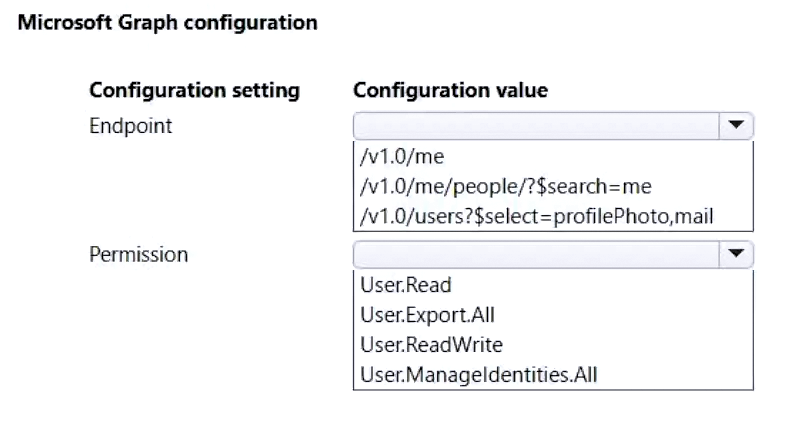
-
Case study
-
This is a case study. Case studies are not timed separately. You can use as much exam time as you would like to complete each case. However, there may be additional case studies and sections on this exam. You must manage your time to ensure that you are able to complete all questions included on this exam in the time provided.
To answer the questions included in a case study, you will need to reference information that is provided in the case study. Case studies might contain exhibits and other resources that provide more information about the scenario that is described in the case study. Each question is independent of the other questions in this case study.
At the end of this case study, a review screen will appear. This screen allows you to review your answers and to make changes before you move to the next section of the exam. After you begin a new section, you cannot return to this section.
To start the case study
-
To display the first question in this case study, click the Next button. Use the buttons in the left pane to explore the content of the case study before you answer the questions. Clicking these buttons displays information such as business requirements, existing environment, and problem statements. When you are ready to answer a question, click the Question button to return to the question.
Background
-
Munson’s Pickles and Preserves Farm is an agricultural cooperative corporation based in Washington, US, with farms located across the United States. The company supports agricultural production resources by distributing seeds fertilizers, chemicals, fuel, and farm machinery to the farms.
Current Environment
-
The company is migrating all applications from an on-premises datacenter to Microsoft Azure. Applications support distributors, farmers, and internal company staff.
Corporate website
-
• The company hosts a public website located at http://www.munsonspicklesandpreservesfarm.com. The site supports farmers and distributors who request agricultural production resources.
Farms
-
• The company created a new customer tenant in the Microsoft Entra admin center to support authentication and authorization for applications.
Distributors
-
• Distributors integrate their applications with data that is accessible by using APIs hosted at http://www.munsonspicklesandpreservesfarm.com/api to receive and update resource data.
Requirements
-
The application components must meet the following requirements:
Corporate website
-
• The site must be migrated to Azure App Service.
• Costs must be minimized when hosting in Azure.
• Applications must automatically scale independent of the compute resources.
• All code changes must be validated by internal staff before release to production.
• File transfer speeds must improve, and webpage-load performance must increase.
• All site settings must be centrally stored, secured without using secrets, and encrypted at rest and in transit.
• A queue-based load leveling pattern must be implemented by using Azure Service Bus queues to support high volumes of website agricultural production resource requests.
Farms
-
• Farmers must authenticate to applications by using Microsoft Entra ID.
Distributors
-
• The company must track a custom telemetry value with each API call and monitor performance of all APIs.
• API telemetry values must be charted to evaluate variations and trends for resource data.
Internal staff
-
• App and API updates must be validated before release to production.
• Staff must be able to select a link to direct them back to the production app when validating an app or API update.
• Staff profile photos and email must be displayed on the website once they authenticate to applications by using their Microsoft Entra ID.
Security
-
• All web communications must be secured by using TLS/HTTPS.
• Web content must be restricted by country/region to support corporate compliance standards.
• The principle of least privilege must be applied when providing any user rights or process access rights.
• Managed identities for Azure resources must be used to authenticate services that support Microsoft Entra ID authentication.
Issues
-
Corporate website
-
• Farmers report HTTP 503 errors at the same time as internal staff report that CPU and memory usage are high.
• Distributors report HTTP 502 errors at the same time as internal staff report that average response times and networking traffic are high.
• Internal staff report webpage load sizes are large and take a long time to load.
• Developers receive authentication errors to Service Bus when they debug locally.
Distributors
-
• Many API telemetry values are sent in a short period of time. Telemetry traffic, data costs, and storage costs must be reduced while preserving a statistically correct analysis of the data points sent by the APIs.
You need to display the profile photo and email for signed-in internal staff on the website.
Which Microsoft Graph configuration should you use? To answer, select the appropriate options in the answer area.
NOTE: Each correct selection is worth one point.

Question #386
Case study -
This is a case study. Case studies are not timed separately. You can use as much exam time as you would like to complete each case. However, there may be additional case studies and sections on this exam. You must manage your time to ensure that you are able to complete all questions included on this exam in the time provided.
To answer the questions included in a case study, you will need to reference information that is provided in the case study. Case studies might contain exhibits and other resources that provide more information about the scenario that is described in the case study. Each question is independent of the other questions in this case study.
At the end of this case study, a review screen will appear. This screen allows you to review your answers and to make changes before you move to the next section of the exam. After you begin a new section, you cannot return to this section.
To start the case study -
To display the first question in this case study, click the Next button. Use the buttons in the left pane to explore the content of the case study before you answer the questions. Clicking these buttons displays information such as business requirements, existing environment, and problem statements. When you are ready to answer a question, click the Question button to return to the question.
Background -
Munson’s Pickles and Preserves Farm is an agricultural cooperative corporation based in Washington, US, with farms located across the United States. The company supports agricultural production resources by distributing seeds fertilizers, chemicals, fuel, and farm machinery to the farms.
Current Environment -
The company is migrating all applications from an on-premises datacenter to Microsoft Azure. Applications support distributors, farmers, and internal company staff.
Corporate website -
• The company hosts a public website located at http://www.munsonspicklesandpreservesfarm.com. The site supports farmers and distributors who request agricultural production resources.
Farms -
• The company created a new customer tenant in the Microsoft Entra admin center to support authentication and authorization for applications.
Distributors -
• Distributors integrate their applications with data that is accessible by using APIs hosted at http://www.munsonspicklesandpreservesfarm.com/api to receive and update resource data.
Requirements -
The application components must meet the following requirements:
Corporate website -
• The site must be migrated to Azure App Service.
• Costs must be minimized when hosting in Azure.
• Applications must automatically scale independent of the compute resources.
• All code changes must be validated by internal staff before release to production.
• File transfer speeds must improve, and webpage-load performance must increase.
• All site settings must be centrally stored, secured without using secrets, and encrypted at rest and in transit.
• A queue-based load leveling pattern must be implemented by using Azure Service Bus queues to support high volumes of website agricultural production resource requests.
Farms -
• Farmers must authenticate to applications by using Microsoft Entra ID.
Distributors -
• The company must track a custom telemetry value with each API call and monitor performance of all APIs.
• API telemetry values must be charted to evaluate variations and trends for resource data.
Internal staff -
• App and API updates must be validated before release to production.
• Staff must be able to select a link to direct them back to the production app when validating an app or API update.
• Staff profile photos and email must be displayed on the website once they authenticate to applications by using their Microsoft Entra ID.
Security -
• All web communications must be secured by using TLS/HTTPS.
• Web content must be restricted by country/region to support corporate compliance standards.
• The principle of least privilege must be applied when providing any user rights or process access rights.
• Managed identities for Azure resources must be used to authenticate services that support Microsoft Entra ID authentication.
Issues -
Corporate website -
• Farmers report HTTP 503 errors at the same time as internal staff report that CPU and memory usage are high.
• Distributors report HTTP 502 errors at the same time as internal staff report that average response times and networking traffic are high.
• Internal staff report webpage load sizes are large and take a long time to load.
• Developers receive authentication errors to Service Bus when they debug locally.
Distributors -
• Many API telemetry values are sent in a short period of time. Telemetry traffic, data costs, and storage costs must be reduced while preserving a statistically correct analysis of the data points sent by the APIs.
You need to configure all site configuration settings for the corporate website.
Which three actions should you perform? Each correct answer presents part of the solution.
NOTE: Each correct selection is worth one point.
This is a case study. Case studies are not timed separately. You can use as much exam time as you would like to complete each case. However, there may be additional case studies and sections on this exam. You must manage your time to ensure that you are able to complete all questions included on this exam in the time provided.
To answer the questions included in a case study, you will need to reference information that is provided in the case study. Case studies might contain exhibits and other resources that provide more information about the scenario that is described in the case study. Each question is independent of the other questions in this case study.
At the end of this case study, a review screen will appear. This screen allows you to review your answers and to make changes before you move to the next section of the exam. After you begin a new section, you cannot return to this section.
To start the case study -
To display the first question in this case study, click the Next button. Use the buttons in the left pane to explore the content of the case study before you answer the questions. Clicking these buttons displays information such as business requirements, existing environment, and problem statements. When you are ready to answer a question, click the Question button to return to the question.
Background -
Munson’s Pickles and Preserves Farm is an agricultural cooperative corporation based in Washington, US, with farms located across the United States. The company supports agricultural production resources by distributing seeds fertilizers, chemicals, fuel, and farm machinery to the farms.
Current Environment -
The company is migrating all applications from an on-premises datacenter to Microsoft Azure. Applications support distributors, farmers, and internal company staff.
Corporate website -
• The company hosts a public website located at http://www.munsonspicklesandpreservesfarm.com. The site supports farmers and distributors who request agricultural production resources.
Farms -
• The company created a new customer tenant in the Microsoft Entra admin center to support authentication and authorization for applications.
Distributors -
• Distributors integrate their applications with data that is accessible by using APIs hosted at http://www.munsonspicklesandpreservesfarm.com/api to receive and update resource data.
Requirements -
The application components must meet the following requirements:
Corporate website -
• The site must be migrated to Azure App Service.
• Costs must be minimized when hosting in Azure.
• Applications must automatically scale independent of the compute resources.
• All code changes must be validated by internal staff before release to production.
• File transfer speeds must improve, and webpage-load performance must increase.
• All site settings must be centrally stored, secured without using secrets, and encrypted at rest and in transit.
• A queue-based load leveling pattern must be implemented by using Azure Service Bus queues to support high volumes of website agricultural production resource requests.
Farms -
• Farmers must authenticate to applications by using Microsoft Entra ID.
Distributors -
• The company must track a custom telemetry value with each API call and monitor performance of all APIs.
• API telemetry values must be charted to evaluate variations and trends for resource data.
Internal staff -
• App and API updates must be validated before release to production.
• Staff must be able to select a link to direct them back to the production app when validating an app or API update.
• Staff profile photos and email must be displayed on the website once they authenticate to applications by using their Microsoft Entra ID.
Security -
• All web communications must be secured by using TLS/HTTPS.
• Web content must be restricted by country/region to support corporate compliance standards.
• The principle of least privilege must be applied when providing any user rights or process access rights.
• Managed identities for Azure resources must be used to authenticate services that support Microsoft Entra ID authentication.
Issues -
Corporate website -
• Farmers report HTTP 503 errors at the same time as internal staff report that CPU and memory usage are high.
• Distributors report HTTP 502 errors at the same time as internal staff report that average response times and networking traffic are high.
• Internal staff report webpage load sizes are large and take a long time to load.
• Developers receive authentication errors to Service Bus when they debug locally.
Distributors -
• Many API telemetry values are sent in a short period of time. Telemetry traffic, data costs, and storage costs must be reduced while preserving a statistically correct analysis of the data points sent by the APIs.
You need to configure all site configuration settings for the corporate website.
Which three actions should you perform? Each correct answer presents part of the solution.
NOTE: Each correct selection is worth one point.
Question #387
You are developing an application that uses keys stored in Azure Key Vault.
You need to enforce a specific cryptographic algorithm and key size for keys stored in the vault.
What should you use?
You need to enforce a specific cryptographic algorithm and key size for keys stored in the vault.
What should you use?
Question #388
Case study -
This is a case study. Case studies are not timed separately. You can use as much exam time as you would like to complete each case. However, there may be additional case studies and sections on this exam. You must manage your time to ensure that you are able to complete all questions included on this exam in the time provided.
To answer the questions included in a case study, you will need to reference information that is provided in the case study. Case studies might contain exhibits and other resources that provide more information about the scenario that is described in the case study. Each question is independent of the other questions in this case study.
At the end of this case study, a review screen will appear. This screen allows you to review your answers and to make changes before you move to the next section of the exam. After you begin a new section, you cannot return to this section.
To start the case study -
To display the first question in this case study, click the Next button. Use the buttons in the left pane to explore the content of the case study before you answer the questions. Clicking these buttons displays information such as business requirements, existing environment, and problem statements. When you are ready to answer a question, click the Question button to return to the question.
Background -
Munson’s Pickles and Preserves Farm is an agricultural cooperative corporation based in Washington, US, with farms located across the United States. The company supports agricultural production resources by distributing seeds fertilizers, chemicals, fuel, and farm machinery to the farms.
Current Environment -
The company is migrating all applications from an on-premises datacenter to Microsoft Azure. Applications support distributors, farmers, and internal company staff.
Corporate website -
• The company hosts a public website located at http://www.munsonspicklesandpreservesfarm.com. The site supports farmers and distributors who request agricultural production resources.
Farms -
• The company created a new customer tenant in the Microsoft Entra admin center to support authentication and authorization for applications.
Distributors -
• Distributors integrate their applications with data that is accessible by using APIs hosted at http://www.munsonspicklesandpreservesfarm.com/api to receive and update resource data.
Requirements -
The application components must meet the following requirements:
Corporate website -
• The site must be migrated to Azure App Service.
• Costs must be minimized when hosting in Azure.
• Applications must automatically scale independent of the compute resources.
• All code changes must be validated by internal staff before release to production.
• File transfer speeds must improve, and webpage-load performance must increase.
• All site settings must be centrally stored, secured without using secrets, and encrypted at rest and in transit.
• A queue-based load leveling pattern must be implemented by using Azure Service Bus queues to support high volumes of website agricultural production resource requests.
Farms -
• Farmers must authenticate to applications by using Microsoft Entra ID.
Distributors -
• The company must track a custom telemetry value with each API call and monitor performance of all APIs.
• API telemetry values must be charted to evaluate variations and trends for resource data.
Internal staff -
• App and API updates must be validated before release to production.
• Staff must be able to select a link to direct them back to the production app when validating an app or API update.
• Staff profile photos and email must be displayed on the website once they authenticate to applications by using their Microsoft Entra ID.
Security -
• All web communications must be secured by using TLS/HTTPS.
• Web content must be restricted by country/region to support corporate compliance standards.
• The principle of least privilege must be applied when providing any user rights or process access rights.
• Managed identities for Azure resources must be used to authenticate services that support Microsoft Entra ID authentication.
Issues -
Corporate website -
• Farmers report HTTP 503 errors at the same time as internal staff report that CPU and memory usage are high.
• Distributors report HTTP 502 errors at the same time as internal staff report that average response times and networking traffic are high.
• Internal staff report webpage load sizes are large and take a long time to load.
• Developers receive authentication errors to Service Bus when they debug locally.
Distributors -
• Many API telemetry values are sent in a short period of time. Telemetry traffic, data costs, and storage costs must be reduced while preserving a statistically correct analysis of the data points sent by the APIs.
You need to implement an aggregate of telemetry values for distributor API calls.
Which Application Insights API method should you use?
This is a case study. Case studies are not timed separately. You can use as much exam time as you would like to complete each case. However, there may be additional case studies and sections on this exam. You must manage your time to ensure that you are able to complete all questions included on this exam in the time provided.
To answer the questions included in a case study, you will need to reference information that is provided in the case study. Case studies might contain exhibits and other resources that provide more information about the scenario that is described in the case study. Each question is independent of the other questions in this case study.
At the end of this case study, a review screen will appear. This screen allows you to review your answers and to make changes before you move to the next section of the exam. After you begin a new section, you cannot return to this section.
To start the case study -
To display the first question in this case study, click the Next button. Use the buttons in the left pane to explore the content of the case study before you answer the questions. Clicking these buttons displays information such as business requirements, existing environment, and problem statements. When you are ready to answer a question, click the Question button to return to the question.
Background -
Munson’s Pickles and Preserves Farm is an agricultural cooperative corporation based in Washington, US, with farms located across the United States. The company supports agricultural production resources by distributing seeds fertilizers, chemicals, fuel, and farm machinery to the farms.
Current Environment -
The company is migrating all applications from an on-premises datacenter to Microsoft Azure. Applications support distributors, farmers, and internal company staff.
Corporate website -
• The company hosts a public website located at http://www.munsonspicklesandpreservesfarm.com. The site supports farmers and distributors who request agricultural production resources.
Farms -
• The company created a new customer tenant in the Microsoft Entra admin center to support authentication and authorization for applications.
Distributors -
• Distributors integrate their applications with data that is accessible by using APIs hosted at http://www.munsonspicklesandpreservesfarm.com/api to receive and update resource data.
Requirements -
The application components must meet the following requirements:
Corporate website -
• The site must be migrated to Azure App Service.
• Costs must be minimized when hosting in Azure.
• Applications must automatically scale independent of the compute resources.
• All code changes must be validated by internal staff before release to production.
• File transfer speeds must improve, and webpage-load performance must increase.
• All site settings must be centrally stored, secured without using secrets, and encrypted at rest and in transit.
• A queue-based load leveling pattern must be implemented by using Azure Service Bus queues to support high volumes of website agricultural production resource requests.
Farms -
• Farmers must authenticate to applications by using Microsoft Entra ID.
Distributors -
• The company must track a custom telemetry value with each API call and monitor performance of all APIs.
• API telemetry values must be charted to evaluate variations and trends for resource data.
Internal staff -
• App and API updates must be validated before release to production.
• Staff must be able to select a link to direct them back to the production app when validating an app or API update.
• Staff profile photos and email must be displayed on the website once they authenticate to applications by using their Microsoft Entra ID.
Security -
• All web communications must be secured by using TLS/HTTPS.
• Web content must be restricted by country/region to support corporate compliance standards.
• The principle of least privilege must be applied when providing any user rights or process access rights.
• Managed identities for Azure resources must be used to authenticate services that support Microsoft Entra ID authentication.
Issues -
Corporate website -
• Farmers report HTTP 503 errors at the same time as internal staff report that CPU and memory usage are high.
• Distributors report HTTP 502 errors at the same time as internal staff report that average response times and networking traffic are high.
• Internal staff report webpage load sizes are large and take a long time to load.
• Developers receive authentication errors to Service Bus when they debug locally.
Distributors -
• Many API telemetry values are sent in a short period of time. Telemetry traffic, data costs, and storage costs must be reduced while preserving a statistically correct analysis of the data points sent by the APIs.
You need to implement an aggregate of telemetry values for distributor API calls.
Which Application Insights API method should you use?
Question #389
DRAG DROP
-
Case study
-
This is a case study. Case studies are not timed separately. You can use as much exam time as you would like to complete each case. However, there may be additional case studies and sections on this exam. You must manage your time to ensure that you are able to complete all questions included on this exam in the time provided.
To answer the questions included in a case study, you will need to reference information that is provided in the case study. Case studies might contain exhibits and other resources that provide more information about the scenario that is described in the case study. Each question is independent of the other questions in this case study.
At the end of this case study, a review screen will appear. This screen allows you to review your answers and to make changes before you move to the next section of the exam. After you begin a new section, you cannot return to this section.
To start the case study
-
To display the first question in this case study, click the Next button. Use the buttons in the left pane to explore the content of the case study before you answer the questions. Clicking these buttons displays information such as business requirements, existing environment, and problem statements. When you are ready to answer a question, click the Question button to return to the question.
Background
-
Munson’s Pickles and Preserves Farm is an agricultural cooperative corporation based in Washington, US, with farms located across the United States. The company supports agricultural production resources by distributing seeds fertilizers, chemicals, fuel, and farm machinery to the farms.
Current Environment
-
The company is migrating all applications from an on-premises datacenter to Microsoft Azure. Applications support distributors, farmers, and internal company staff.
Corporate website
-
• The company hosts a public website located at http://www.munsonspicklesandpreservesfarm.com. The site supports farmers and distributors who request agricultural production resources.
Farms
-
• The company created a new customer tenant in the Microsoft Entra admin center to support authentication and authorization for applications.
Distributors
-
• Distributors integrate their applications with data that is accessible by using APIs hosted at http://www.munsonspicklesandpreservesfarm.com/api to receive and update resource data.
Requirements
-
The application components must meet the following requirements:
Corporate website
-
• The site must be migrated to Azure App Service.
• Costs must be minimized when hosting in Azure.
• Applications must automatically scale independent of the compute resources.
• All code changes must be validated by internal staff before release to production.
• File transfer speeds must improve, and webpage-load performance must increase.
• All site settings must be centrally stored, secured without using secrets, and encrypted at rest and in transit.
• A queue-based load leveling pattern must be implemented by using Azure Service Bus queues to support high volumes of website agricultural production resource requests.
Farms
-
• Farmers must authenticate to applications by using Microsoft Entra ID.
Distributors
-
• The company must track a custom telemetry value with each API call and monitor performance of all APIs.
• API telemetry values must be charted to evaluate variations and trends for resource data.
Internal staff
-
• App and API updates must be validated before release to production.
• Staff must be able to select a link to direct them back to the production app when validating an app or API update.
• Staff profile photos and email must be displayed on the website once they authenticate to applications by using their Microsoft Entra ID.
Security
-
• All web communications must be secured by using TLS/HTTPS.
• Web content must be restricted by country/region to support corporate compliance standards.
• The principle of least privilege must be applied when providing any user rights or process access rights.
• Managed identities for Azure resources must be used to authenticate services that support Microsoft Entra ID authentication.
Issues
-
Corporate website
-
• Farmers report HTTP 503 errors at the same time as internal staff report that CPU and memory usage are high.
• Distributors report HTTP 502 errors at the same time as internal staff report that average response times and networking traffic are high.
• Internal staff report webpage load sizes are large and take a long time to load.
• Developers receive authentication errors to Service Bus when they debug locally.
Distributors
-
• Many API telemetry values are sent in a short period of time. Telemetry traffic, data costs, and storage costs must be reduced while preserving a statistically correct analysis of the data points sent by the APIs.
You need to correct the internal staff issue with webpages.
Which three actions should you perform in sequence? To answer, move the appropriate actions from the list of actions to the answer area and arrange them in the correct order.
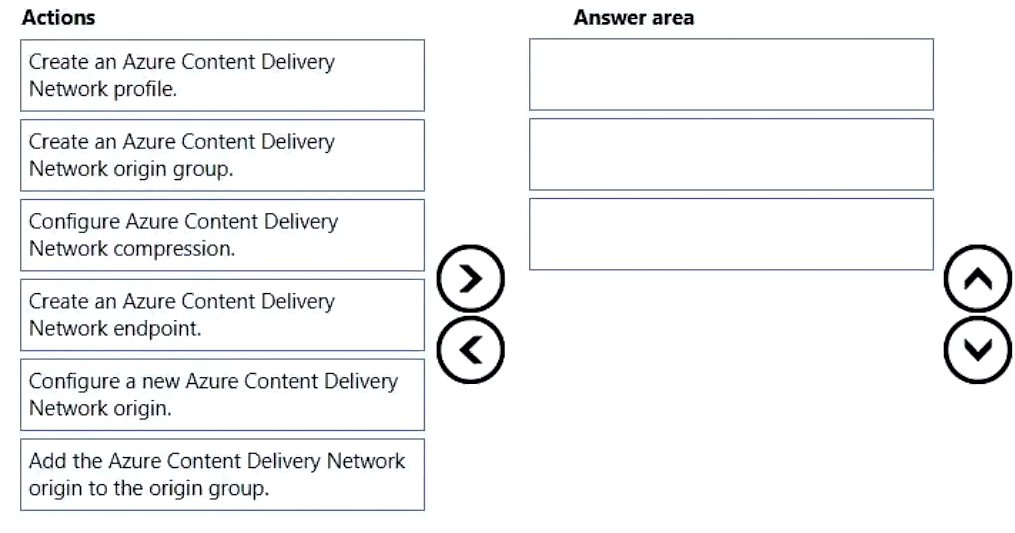
-
Case study
-
This is a case study. Case studies are not timed separately. You can use as much exam time as you would like to complete each case. However, there may be additional case studies and sections on this exam. You must manage your time to ensure that you are able to complete all questions included on this exam in the time provided.
To answer the questions included in a case study, you will need to reference information that is provided in the case study. Case studies might contain exhibits and other resources that provide more information about the scenario that is described in the case study. Each question is independent of the other questions in this case study.
At the end of this case study, a review screen will appear. This screen allows you to review your answers and to make changes before you move to the next section of the exam. After you begin a new section, you cannot return to this section.
To start the case study
-
To display the first question in this case study, click the Next button. Use the buttons in the left pane to explore the content of the case study before you answer the questions. Clicking these buttons displays information such as business requirements, existing environment, and problem statements. When you are ready to answer a question, click the Question button to return to the question.
Background
-
Munson’s Pickles and Preserves Farm is an agricultural cooperative corporation based in Washington, US, with farms located across the United States. The company supports agricultural production resources by distributing seeds fertilizers, chemicals, fuel, and farm machinery to the farms.
Current Environment
-
The company is migrating all applications from an on-premises datacenter to Microsoft Azure. Applications support distributors, farmers, and internal company staff.
Corporate website
-
• The company hosts a public website located at http://www.munsonspicklesandpreservesfarm.com. The site supports farmers and distributors who request agricultural production resources.
Farms
-
• The company created a new customer tenant in the Microsoft Entra admin center to support authentication and authorization for applications.
Distributors
-
• Distributors integrate their applications with data that is accessible by using APIs hosted at http://www.munsonspicklesandpreservesfarm.com/api to receive and update resource data.
Requirements
-
The application components must meet the following requirements:
Corporate website
-
• The site must be migrated to Azure App Service.
• Costs must be minimized when hosting in Azure.
• Applications must automatically scale independent of the compute resources.
• All code changes must be validated by internal staff before release to production.
• File transfer speeds must improve, and webpage-load performance must increase.
• All site settings must be centrally stored, secured without using secrets, and encrypted at rest and in transit.
• A queue-based load leveling pattern must be implemented by using Azure Service Bus queues to support high volumes of website agricultural production resource requests.
Farms
-
• Farmers must authenticate to applications by using Microsoft Entra ID.
Distributors
-
• The company must track a custom telemetry value with each API call and monitor performance of all APIs.
• API telemetry values must be charted to evaluate variations and trends for resource data.
Internal staff
-
• App and API updates must be validated before release to production.
• Staff must be able to select a link to direct them back to the production app when validating an app or API update.
• Staff profile photos and email must be displayed on the website once they authenticate to applications by using their Microsoft Entra ID.
Security
-
• All web communications must be secured by using TLS/HTTPS.
• Web content must be restricted by country/region to support corporate compliance standards.
• The principle of least privilege must be applied when providing any user rights or process access rights.
• Managed identities for Azure resources must be used to authenticate services that support Microsoft Entra ID authentication.
Issues
-
Corporate website
-
• Farmers report HTTP 503 errors at the same time as internal staff report that CPU and memory usage are high.
• Distributors report HTTP 502 errors at the same time as internal staff report that average response times and networking traffic are high.
• Internal staff report webpage load sizes are large and take a long time to load.
• Developers receive authentication errors to Service Bus when they debug locally.
Distributors
-
• Many API telemetry values are sent in a short period of time. Telemetry traffic, data costs, and storage costs must be reduced while preserving a statistically correct analysis of the data points sent by the APIs.
You need to correct the internal staff issue with webpages.
Which three actions should you perform in sequence? To answer, move the appropriate actions from the list of actions to the answer area and arrange them in the correct order.

Question #390
HOTSPOT
-
Case study
-
This is a case study. Case studies are not timed separately. You can use as much exam time as you would like to complete each case. However, there may be additional case studies and sections on this exam. You must manage your time to ensure that you are able to complete all questions included on this exam in the time provided.
To answer the questions included in a case study, you will need to reference information that is provided in the case study. Case studies might contain exhibits and other resources that provide more information about the scenario that is described in the case study. Each question is independent of the other questions in this case study.
At the end of this case study, a review screen will appear. This screen allows you to review your answers and to make changes before you move to the next section of the exam. After you begin a new section, you cannot return to this section.
To start the case study
-
To display the first question in this case study, click the Next button. Use the buttons in the left pane to explore the content of the case study before you answer the questions. Clicking these buttons displays information such as business requirements, existing environment, and problem statements. When you are ready to answer a question, click the Question button to return to the question.
Background
-
Munson’s Pickles and Preserves Farm is an agricultural cooperative corporation based in Washington, US, with farms located across the United States. The company supports agricultural production resources by distributing seeds fertilizers, chemicals, fuel, and farm machinery to the farms.
Current Environment
-
The company is migrating all applications from an on-premises datacenter to Microsoft Azure. Applications support distributors, farmers, and internal company staff.
Corporate website
-
• The company hosts a public website located at http://www.munsonspicklesandpreservesfarm.com. The site supports farmers and distributors who request agricultural production resources.
Farms
-
• The company created a new customer tenant in the Microsoft Entra admin center to support authentication and authorization for applications.
Distributors
-
• Distributors integrate their applications with data that is accessible by using APIs hosted at http://www.munsonspicklesandpreservesfarm.com/api to receive and update resource data.
Requirements
-
The application components must meet the following requirements:
Corporate website
-
• The site must be migrated to Azure App Service.
• Costs must be minimized when hosting in Azure.
• Applications must automatically scale independent of the compute resources.
• All code changes must be validated by internal staff before release to production.
• File transfer speeds must improve, and webpage-load performance must increase.
• All site settings must be centrally stored, secured without using secrets, and encrypted at rest and in transit.
• A queue-based load leveling pattern must be implemented by using Azure Service Bus queues to support high volumes of website agricultural production resource requests.
Farms
-
• Farmers must authenticate to applications by using Microsoft Entra ID.
Distributors
-
• The company must track a custom telemetry value with each API call and monitor performance of all APIs.
• API telemetry values must be charted to evaluate variations and trends for resource data.
Internal staff
-
• App and API updates must be validated before release to production.
• Staff must be able to select a link to direct them back to the production app when validating an app or API update.
• Staff profile photos and email must be displayed on the website once they authenticate to applications by using their Microsoft Entra ID.
Security
-
• All web communications must be secured by using TLS/HTTPS.
• Web content must be restricted by country/region to support corporate compliance standards.
• The principle of least privilege must be applied when providing any user rights or process access rights.
• Managed identities for Azure resources must be used to authenticate services that support Microsoft Entra ID authentication.
Issues
-
Corporate website
-
• Farmers report HTTP 503 errors at the same time as internal staff report that CPU and memory usage are high.
• Distributors report HTTP 502 errors at the same time as internal staff report that average response times and networking traffic are high.
• Internal staff report webpage load sizes are large and take a long time to load.
• Developers receive authentication errors to Service Bus when they debug locally.
Distributors
-
• Many API telemetry values are sent in a short period of time. Telemetry traffic, data costs, and storage costs must be reduced while preserving a statistically correct analysis of the data points sent by the APIs.
You need to correct the errors for farmers and distributors.
Which solution should you use? To answer, select the appropriate options in the answer area.
NOTE: Each correct selection is worth one point.
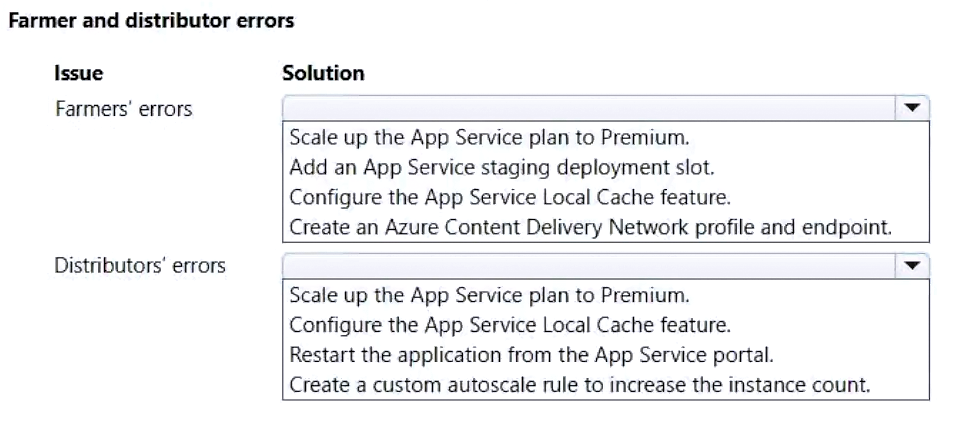
-
Case study
-
This is a case study. Case studies are not timed separately. You can use as much exam time as you would like to complete each case. However, there may be additional case studies and sections on this exam. You must manage your time to ensure that you are able to complete all questions included on this exam in the time provided.
To answer the questions included in a case study, you will need to reference information that is provided in the case study. Case studies might contain exhibits and other resources that provide more information about the scenario that is described in the case study. Each question is independent of the other questions in this case study.
At the end of this case study, a review screen will appear. This screen allows you to review your answers and to make changes before you move to the next section of the exam. After you begin a new section, you cannot return to this section.
To start the case study
-
To display the first question in this case study, click the Next button. Use the buttons in the left pane to explore the content of the case study before you answer the questions. Clicking these buttons displays information such as business requirements, existing environment, and problem statements. When you are ready to answer a question, click the Question button to return to the question.
Background
-
Munson’s Pickles and Preserves Farm is an agricultural cooperative corporation based in Washington, US, with farms located across the United States. The company supports agricultural production resources by distributing seeds fertilizers, chemicals, fuel, and farm machinery to the farms.
Current Environment
-
The company is migrating all applications from an on-premises datacenter to Microsoft Azure. Applications support distributors, farmers, and internal company staff.
Corporate website
-
• The company hosts a public website located at http://www.munsonspicklesandpreservesfarm.com. The site supports farmers and distributors who request agricultural production resources.
Farms
-
• The company created a new customer tenant in the Microsoft Entra admin center to support authentication and authorization for applications.
Distributors
-
• Distributors integrate their applications with data that is accessible by using APIs hosted at http://www.munsonspicklesandpreservesfarm.com/api to receive and update resource data.
Requirements
-
The application components must meet the following requirements:
Corporate website
-
• The site must be migrated to Azure App Service.
• Costs must be minimized when hosting in Azure.
• Applications must automatically scale independent of the compute resources.
• All code changes must be validated by internal staff before release to production.
• File transfer speeds must improve, and webpage-load performance must increase.
• All site settings must be centrally stored, secured without using secrets, and encrypted at rest and in transit.
• A queue-based load leveling pattern must be implemented by using Azure Service Bus queues to support high volumes of website agricultural production resource requests.
Farms
-
• Farmers must authenticate to applications by using Microsoft Entra ID.
Distributors
-
• The company must track a custom telemetry value with each API call and monitor performance of all APIs.
• API telemetry values must be charted to evaluate variations and trends for resource data.
Internal staff
-
• App and API updates must be validated before release to production.
• Staff must be able to select a link to direct them back to the production app when validating an app or API update.
• Staff profile photos and email must be displayed on the website once they authenticate to applications by using their Microsoft Entra ID.
Security
-
• All web communications must be secured by using TLS/HTTPS.
• Web content must be restricted by country/region to support corporate compliance standards.
• The principle of least privilege must be applied when providing any user rights or process access rights.
• Managed identities for Azure resources must be used to authenticate services that support Microsoft Entra ID authentication.
Issues
-
Corporate website
-
• Farmers report HTTP 503 errors at the same time as internal staff report that CPU and memory usage are high.
• Distributors report HTTP 502 errors at the same time as internal staff report that average response times and networking traffic are high.
• Internal staff report webpage load sizes are large and take a long time to load.
• Developers receive authentication errors to Service Bus when they debug locally.
Distributors
-
• Many API telemetry values are sent in a short period of time. Telemetry traffic, data costs, and storage costs must be reduced while preserving a statistically correct analysis of the data points sent by the APIs.
You need to correct the errors for farmers and distributors.
Which solution should you use? To answer, select the appropriate options in the answer area.
NOTE: Each correct selection is worth one point.

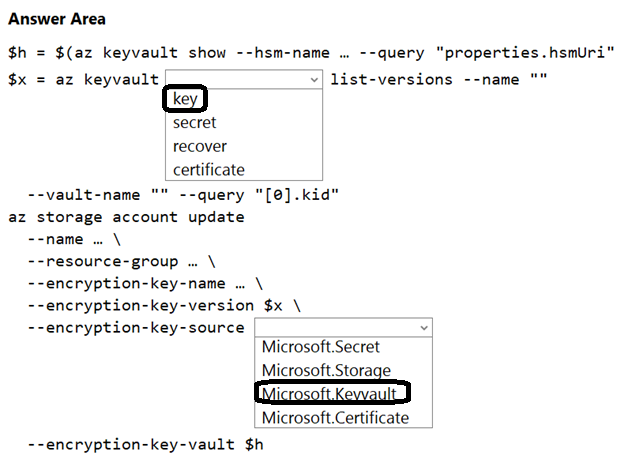
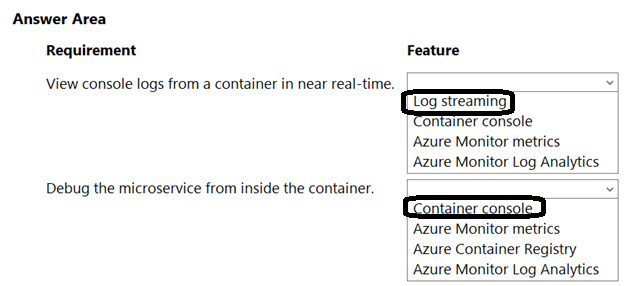
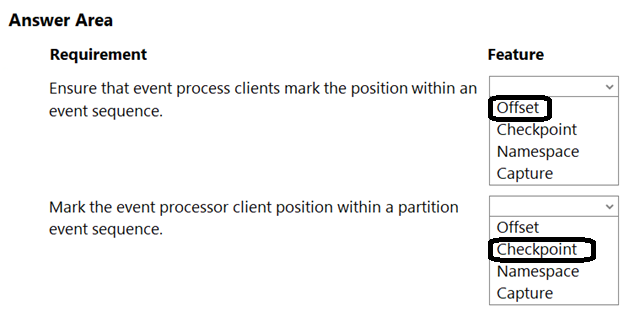
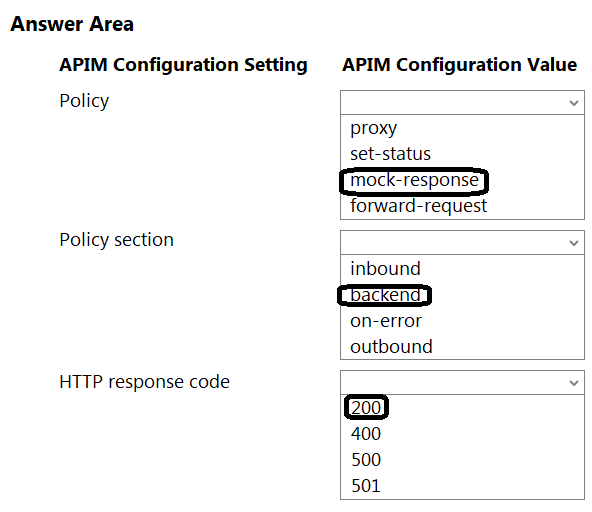



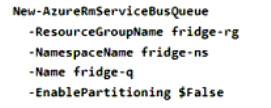
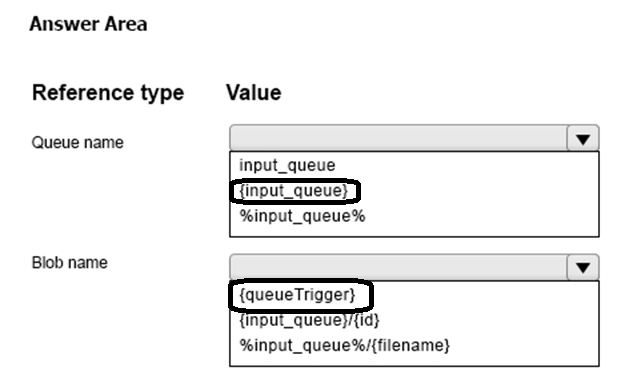
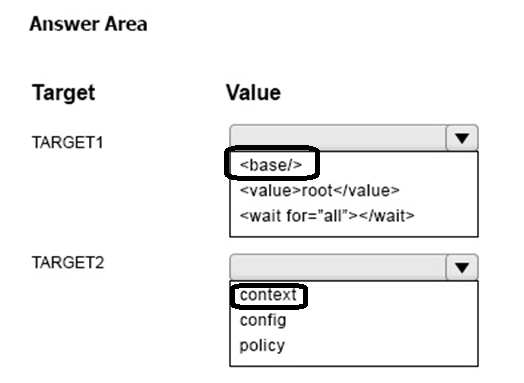
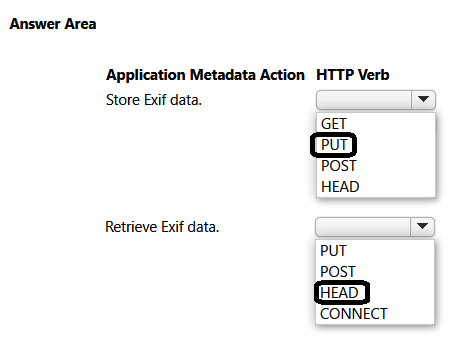
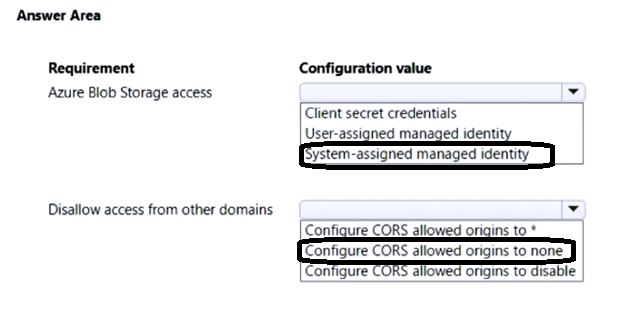













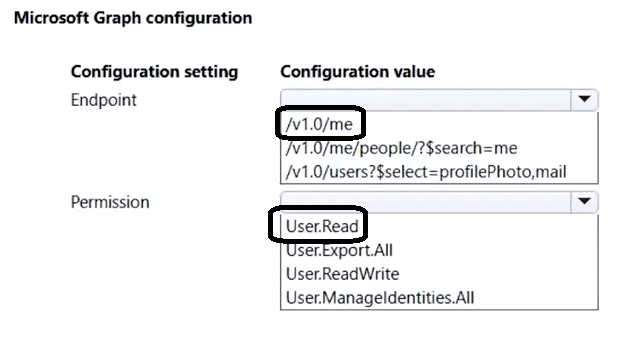
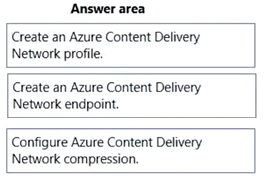
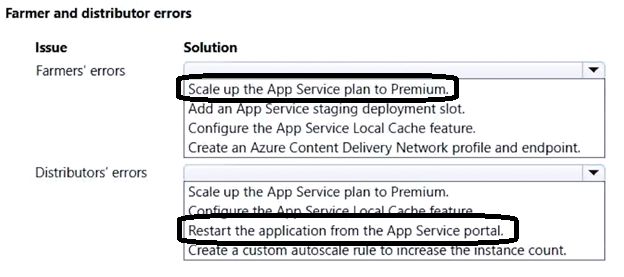
No comments:
Post a Comment